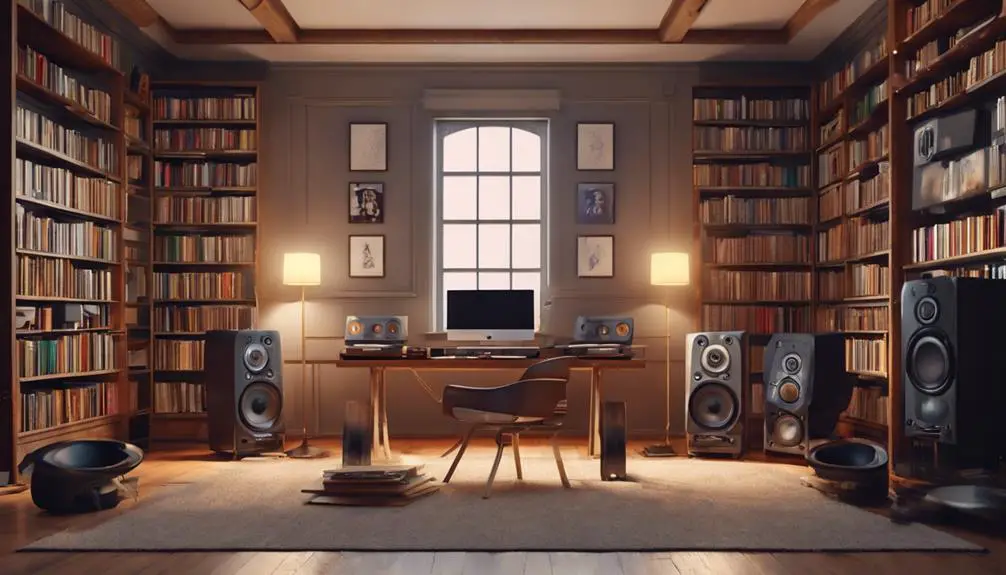Isn't it intriguing how the same sound can evoke entirely different experiences? When it comes to choosing between bookshelf speakers and studio monitors, you're faced with a decision that hinges on your listening habits and environment. Bookshelf speakers promise a warm, immersive experience for casual enjoyment, while studio monitors offer precision for critical listening. Each option has its merits and challenges, but understanding the nuances can be essential in making the right choice for your audio needs. What factors will ultimately sway your decision?
Understanding Bookshelf Speakers
Bookshelf speakers are compact audio devices designed to deliver high-quality sound while fitting neatly on shelves or furniture. If you're looking to enhance your audio experience without taking up too much space, these speakers are an excellent choice. They're versatile, making them suitable for various environments, from living rooms to offices.
When choosing bookshelf speakers, it's important to evaluate their power output, frequency response, and size. You'll want speakers that can fill your room with sound without distorting it. Also, check for features like built-in Bluetooth, which can provide convenience while keeping your setup safe and clutter-free.
Ensure you're placing the speakers securely on sturdy surfaces to prevent any accidents, especially in homes with pets or children. Cables should be managed neatly to avoid tripping hazards. Additionally, look for models with protective grilles to safeguard the drivers from potential damage.
Exploring Studio Monitors
While bookshelf speakers excel in casual listening environments, studio monitors are specifically designed for accurate sound reproduction, making them ideal for music production and audio mixing. When you're in a studio setting, you need to hear every detail of your audio clearly, and that's where studio monitors shine. They provide a flat frequency response, meaning they won't color the sound with added bass or treble, allowing you to make critical mixing decisions.
Using studio monitors can help guarantee your audio translates well across various playback systems, from headphones to car speakers. You'll notice that they often come in a bi-amped design, which means they have separate amplifiers for the woofer and tweeter, providing better sound clarity and dynamic range.
When setting up your studio monitors, be mindful of their placement. Positioning them at ear level and away from walls can minimize unwanted reflections, creating a safer listening environment. Additionally, consider using isolation pads to prevent vibrations from affecting your sound quality. In the long run, investing in quality studio monitors will enhance your audio projects while prioritizing your listening safety.
Key Differences Between Them
The key differences between bookshelf speakers and studio monitors lie in their design intentions and sound reproduction capabilities. Bookshelf speakers are typically designed for casual listening, focusing on a pleasant sound profile that enhances music enjoyment. They often emphasize certain frequencies to create a warmer, more engaging audio experience. This can make them sound great for movies and music, but they're not always precise.
On the other hand, studio monitors are engineered for critical listening. They're built to deliver a flat frequency response, meaning they reproduce sound as accurately as possible. This makes them ideal for audio professionals who need to hear every detail in their mixes. If you're mixing music or doing sound design, you'll want studio monitors to guarantee you're making informed decisions based on true sound.
Another difference is the placement and environment. Bookshelf speakers can fit well in various home setups, while studio monitors require careful positioning to achieve the best sound quality. You'll also want to take into account room acoustics when placing studio monitors, as this can greatly impact their performance. Overall, choosing between them depends on your needs—whether you prioritize enjoyment or precision.
Advantages of Each Option
Each option offers distinct advantages tailored to different listening experiences and environments. Bookshelf speakers are designed for casual listening, making them ideal for enjoying music and movies in a home setting. Their warm sound and rich bass can create an inviting atmosphere, enhancing your experience without overwhelming your space. If you're seeking comfort and a more immersive audio experience, bookshelf speakers may be your best choice.
On the other hand, studio monitors are engineered for accuracy, making them perfect for audio production or critical listening. If you're working on music mixing or sound design, these monitors provide a flat frequency response, allowing you to hear every detail without coloration. This precision helps guarantee that your mixes translate well across various playback systems, boosting your confidence in your work.
Choosing between these two options ultimately depends on what you value most in sound quality and environment. If you prioritize a cozy and engaging listening experience, go for bookshelf speakers. If you lean towards professional audio production, studio monitors will serve you better. Both options prioritize safety in their construction, guaranteeing reliable performance in your home.
Choosing the Right One
Deciding between bookshelf speakers and studio monitors hinges on your specific needs and listening habits. If you're looking for an immersive audio experience for casual listening, bookshelf speakers might be your best bet. They're designed to provide a rich soundstage and can enhance your enjoyment while keeping safety in mind. Make sure you position them correctly to avoid any accidents, like tipping or falling, especially in homes with children or pets.
On the other hand, if you're into music production or need accurate sound reproduction, studio monitors are the way to go. They're engineered for precision, giving you a clear, uncolored sound that helps you make informed decisions about your audio projects. Just remember to place them at ear level and away from walls to minimize any potential acoustic issues.
Ultimately, your choice should reflect how you plan to use the speakers. Think about your listening environment, how much space you have, and any safety concerns. By carefully considering these factors, you'll be able to select the option that best fits your lifestyle and guarantees a safe listening experience.

